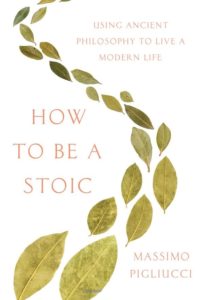How to Be a Stoic: Using Ancient Philosophy to Live a Modern Life

BOOK BY MASSIMO PIGLIUCCI
BASIC BOOKS, 2017
262 PP.; $27.00
A glance at Amazon.com reveals no less than thirty-two books published in 2017 applying the ancient Greco-Roman philosophy of Stoicism to modern life. Fewer books did so in all prior years combined going back to 2000, and there was very little before that. This recent burst of activity can be interpreted as a response to a slowly accumulating interest in Stoicism, fueled in part by a major annual gathering described in Massimo Pigliucci’s latest book, How to Be a Stoic.
Every fall thousands of people participate in Stoic Week, a worldwide philosophy event-cum-social science experiment organized by a team at the University of Exeter in England, with the collaboration of academic philosophers, cognitive therapists, and everyday practitioners all over the world.
The reason Pigliucci’s book on this subject commands our special attention is because of the author’s long association with organized humanism. He is a professor of philosophy by profession and also holds degrees in science. But he has of late grown “downright irritated” with the New Atheists and unsatisfied with secular humanism’s overdependence “on science and a modern conception of rationality.” He finds that humanism “comes across as cold and not the sort of thing you want to bring your kids to on a Sunday morning.” So he’s shifted his focus to Stoicism, in which he finds “a rational, science-friendly philosophy that includes a metaphysics with a spiritual dimension.” He also sees it as “explicitly open to revision” and “eminently practical.”
Not that one needs to abandon one to embrace the other. Pigliucci freely acknowledges that the American Humanist Association’s 1971 Humanist of the Year, psychologist Albert Ellis, rooted his rational-emotive behavior therapy in Stoicism. And, “For all its uniqueness, Stoicism has numerous points of contact…with modern movements such as secular humanism and ethical culture,” he says.
 But today’s humanists might take exception to the ancient Stoic belief in the gods, or actually a “cosmic reason” called the “Logos.” Pigliucci understands this but notes that some Greek and Roman proponents of this school were simply referencing “the rather straightforward observation that the cosmos can be understood rationally” and that the universe “works through a web of cause and effect.” He also thinks, given Stoicism’s history of revising itself, that Stoics would have become as nontheistic as himself had they lived to read the works of David Hume and Charles Darwin. Besides, there was an ambiguity among the ancients about this topic, as evidenced in quotes from Marcus Aurelius in which the Roman emperor argues the irrelevance of theology to basic Stoic ideas. This ambiguity is, in fact, one of the features that attracted Pigliucci to the philosophy in the first place. “Stoics can build a very large tent indeed, welcoming everyone from atheists to agnostics, from pantheists and panentheists to theists.” This is because “what is important in life is to live it well, and that such an objective—the eudaimonic existence sought by the ancients—depends very little on whether there is a God or not.”
But today’s humanists might take exception to the ancient Stoic belief in the gods, or actually a “cosmic reason” called the “Logos.” Pigliucci understands this but notes that some Greek and Roman proponents of this school were simply referencing “the rather straightforward observation that the cosmos can be understood rationally” and that the universe “works through a web of cause and effect.” He also thinks, given Stoicism’s history of revising itself, that Stoics would have become as nontheistic as himself had they lived to read the works of David Hume and Charles Darwin. Besides, there was an ambiguity among the ancients about this topic, as evidenced in quotes from Marcus Aurelius in which the Roman emperor argues the irrelevance of theology to basic Stoic ideas. This ambiguity is, in fact, one of the features that attracted Pigliucci to the philosophy in the first place. “Stoics can build a very large tent indeed, welcoming everyone from atheists to agnostics, from pantheists and panentheists to theists.” This is because “what is important in life is to live it well, and that such an objective—the eudaimonic existence sought by the ancients—depends very little on whether there is a God or not.”
So then, what are the basic contentions of Stoicism that make a secular good life possible?
Using the freed Roman slave Epictetus as his philosophical guide—much as Dante used Virgil as his conductor through Paradise, Purgatory, and Inferno—Pigliucci begins with the Stoic “dichotomy of control.” Epictetus says, “We must make the best of those things that are in our power and take the rest as nature gives it.” Or as American theologian Reinhold Niebuhr would later put it: “God, grant me the serenity to accept the things I cannot change, courage to change the things I can, and wisdom to know the difference.”
The sorts of things most under our control are that very serenity, courage, and wisdom Niebuhr referred to. Least under our control are the conditions and events of life and the outcomes of our actions. These latter the Stoics regarded as indifferent. But some indifferent things were nonetheless preferred and others “dispreferred” according to how well or ill they fostered moral progress and happiness.
Honing our ability to manage this dichotomy of control in the interest of morality and wellbeing constitutes the development of character, a centerpiece of Stoic practice. But part of that character development includes a growth in our patience with and understanding of others who, for one reason or another, have failed to develop their own characters. Thus we may place Stoic demands on ourselves but not on others (unless we have been chosen by others as their instructors).
Pigliucci covers other Stoic ideas and then applies them to such matters as death and suicide, anger and anxiety, love and friendship. The result is a sort of philosophical self-help book that, though advancing a practical philosophy, is written more as a philosophical work than a practical guide. Moreover, because Pigliucci wants to cleave as closely as he can to the original Stoics while applying their ideas to twenty-first century living, he can’t avoid using quotes that need explaining and elements of an ancient Greek terminology that not only were somewhat idiosyncratic in their own day but simply don’t translate well into modern English. This means he wastes the reader’s time with unnecessary explanations of ancient Stoic formulations when he could simply tell us in ordinary language what it all means.
Therefore, for those humanists of a philosophical bent, this book will offer a welcome explanation and application of a particularly useful set of ancient ideas. But for those seeking a practical guide to putting a practical philosophy to work, perhaps one of the other titles may prove more helpful.
